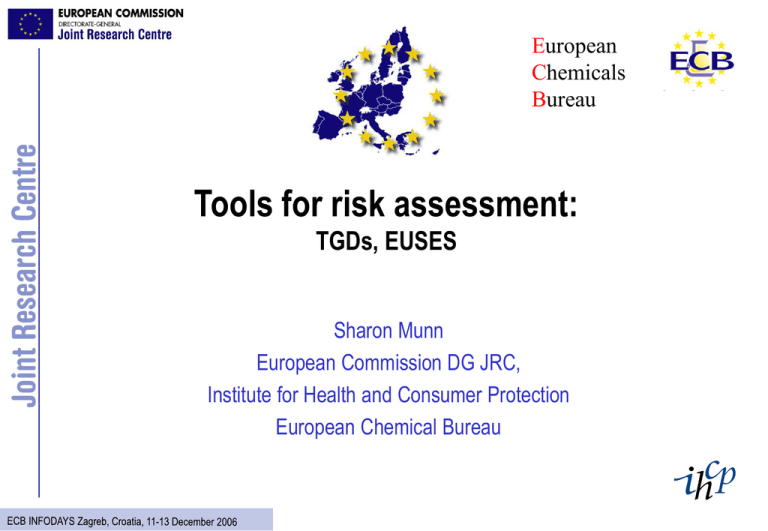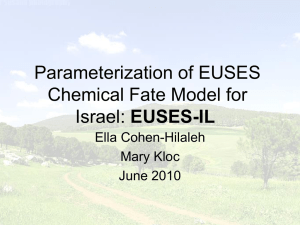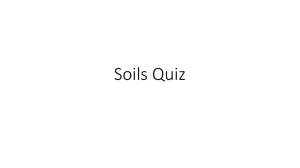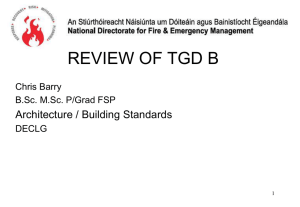Data Collection, Data selection for the Risk Assessment of chemicals
advertisement

European Chemicals Bureau Tools for risk assessment: TGDs, EUSES Sharon Munn European Commission DG JRC, Institute for Health and Consumer Protection European Chemical Bureau EU general process Data collection (step-by-step based on production volume) Automatic priority setting Management committee National priority lists EU priority list in official journal Further data gathering and/or risk assessment Hazard Assessment Exposure Assessment Risk management; (if necessary) incl. strategies for risk reduction Tools to implement Regulation 793/93 1. Data Collection Step HEDSET, IUCLID 2. Priority Setting Step EURAM 3. Risk Assessment Step TGD - RA, EUSES 4. Risk Reduction Step TGD - RR TG D ENVIRONMENT Data requirements for new substances additional studies birds bioaccumulation bioaccumulation prolonged fish prolonged fish earthworms earthworms higher plants higher plants Daphnia, 21-days Daphnia, 21-days algal growth algal growth algal growth acute Daphnia acute Daphnia acute Daphnia acute fish acute fish acute fish bacterial inhibition bacterial inhibition bacterial inhibition Biodegradation adsorption/desorption adsorption/desorption adsorption/desorption biodegradation biodegradation biodegradation none 0.01 0.1 1 10 / 100 1000 t/a Comparison of the Data Requirements Today: New Substances Existing substances REACH: All Substances 0.01 0.1 1 10 100 1000 t/a Implementation Tools of Regulation 793/93 1. Data Collection IUCLID HEDSET Tools to implement Regulation 793/93 1. Data Collection Step HEDSET, IUCLID 2. Priority Setting Step EURAM 3. Risk Assessment Step TGD - RA, EUSES 4. Risk Reduction Step TGD - RR General Process • Priority setting: – Production volume only, e.g. OECD HPV Chemicals Programme (currently 5235 substances on OECD HPV List) – Risk based priority setting system e.g. ESR (EURAM), PBT Chemicals, WFD, – According to use only (BPD) Priority Setting Existing Substances 140 Priority Substances > 2000 HPVCs > 100.000 EINECS substances Priority lists: factors which should be taken into account • the effects of the substance to man or the environment; • the exposure of man or the environment to the substance; • the lack of data on the effects of the substance on man and the environment; • work already carried out in other fora; • other Community legislation and/or programmes relating to dangerous substances. EURAM using IUCLID data Substance may obtain high scores if, for example – it is produced in large volumes – is used in a dispersive manner – persists in the environment – is highly toxic to humans, animals or plants – has long term/chronic effects – is carcinogenic, mutagenic or toxic to reproduction (CMR) – little is known about its properties, use or effects EURAM E U R AM - Pro g ra m m e E U R isk R an kin g M eth od R an kin g of all S u b stan ces in IU C L ID ord ered b y d eg ree of p oten tial ad verse effects C om m en ts b y C om p eten t A u th orities an d In d u stry E xp ert Ju d g em en t S tag e creates ad ju sted R an kin g C om m ission P rop osal for P riority L ist, D iscu ssion with M em b er S tates, O E C D , In d u stry M eetin g for F in al D ecision , P u b lication in O fficial Jou rn al 1 st P riority L ist 2 n d P riority L ist 3 rd P riority L ist 4 th P riority L ist Principles for risk assessment • Part I – General Introduction – Human Health • Part II – Environment • Part III – Use of (Q)SARs, – Use categories, … • Part IV – Emission Scenario Documents Free available on ECB web page http://ecb.jrc.it/tgdoc Introduction of : Instrument for the quantitative assessment of the risks posed by new and existing chemical substances and biocides to man and the environment. EUSES is a coordinated effort of: • EU Member States • The European Commission (DG ENV) • The European Chemicals Bureau (JRC-ECB) • The European Chemical Industry Basic Framework of Risk Assessment Process Data evaluation Exposure assessment Emission rates Data set Effects assessment Single species toxicity data TGD Extrapolation Distribution EUSES PNEC PEC Risk characterization PEC/PNEC Modules of EUSES Exposure assessment Effects assessment Release Extrapolation Effects assessment Workplace exposure to PNECs/MOS STP Local Regional distribution distribution Consumer exposure Exposure of humans/predators Hydrocarbon Block Method Risk characterisation Route-to-route extrapolation Spatial scales of EUSES ARCTIC MODERATE TROPIC CONTINENT REGION exchange LOCAL ENVIRONMENT air background concentrations inflow concentrations water water water sediment sediment natural soil natural soil agricultural soil agricultural industrial soil soil exchange Local emission and distribution a ir lo c a l e m is s io n s grassland agricultural soil leaching groundwater s e w a g e tre a tm e n t p la n t dilution surface water sedimentation sediment Emission Scenario Documents TDG Part IV – – – – – – – – – IC-3 Chemical industry: Chemicals used in synthesis IC-5 Personal/Domestic and IC-6 Public domain IC-10 Photographic industry IC-12 Pulp, paper and board industry IC-13 Textile processing industry IC-14 Paints, lacquers and varnished industry BPT-9 Biocides used as preservatives BPT-6,7&9 Biocides used as preservatives in paper coating and finishing BPT 2 Private and public health area disinfectants and other biocidal products – ….. NEW Emission Scenarios Documents updating EUSES PT Description 1 5 6 Human hygiene biocidal products Drinking water disinfectants In-can preservatives - washing & cleaning fluids - paints & coatings - fluids for paper, textile & leather prod. 7 Film preservatives - plastics - paper & cardboard Wood preservatives Fibre, leather, rubber and polymer preservatives - textiles & fabrics - leather & hides - paper & cardboard - rubber, polymers, etc. 8 9 PT Description 10 Masonry preservatives 11 Liquid-cooling and processing preservatives - cooling systems 12 Slimicides - paper pulp - mineral oil extraction 13 Metal working fluids preservatives 14 Rodenticides 15 Avicides 18 Insecticides 21 Antifouling Non Available Emission Scenarios Documents and the Biocides Product Directive PT 3 4 16 17 19 20 23 Description Veterinary hygiene Food and feed area Molluscicides Piscicides Repellents and attractants Preservatives for food and feedstocks Control of other vertebrates Environmental emission scenarios • Training Course Materials in ECB website: http://ecb.jrc.it/biocides/ESDs Parameter Density of the solid pahse Density of the water phase Density of air Temperature value 2500 1000 1.3 12 unit kgsolid/msolid3 kgwater/mwater3 kgair/mair3 ºC Surface water [Suspended matter] 15 mgsolid/lwater Suspended matter Fraction solids in s.matter Fraction water in s.matter Fraction o.c. in s.matter 0.1 0.9 0.1 msolid3/msusp3 mwater3/msusp3 Kgoc/kgsolid Sediments Fraction solids in sed. Fraction water in sed. Fraction o.c. in sed. solids. 0.2 0.8 0.05 msolid3/msed3 mwater3/msed3 Kgoc/kgsolid Soil Fraction solids in soil Fraction water in soil Fraction o.c. in soil Fraction o.m. in soil 0.6 0.2 0.02 0.034 msolid3/msed3 mwater3/msed3 Kgoc/kgsolid Kgoc/kgsolid Regional distribution Human exposure: pathways Environment air water food soil Human indirect exposure routes Air crops HUMANS dairy products Soil cattle meat Groundwater drinking water Surface water fish Modules of EUSES Exposure assessment Effects assessment Release Extrapolation Effects assessment Workplace exposure to PNECs/MOS STP Local Regional distribution distribution Consumer exposure Exposure of humans/predators Hydrocarbon Block Method Risk characterisation Route-to-route extrapolation Existing Chemicals General decision scheme Decision Scheme PEC/PNEC NO >1 no need for further testing or risk reduction YES can further info lower PEC/PNEC? YES further testing to lower PEC or PNEC NO Risk Reduction Measures Limitations of EUSES • Chemical risk policy of the EC • A model is always a “cartoon of reality” • Model analysis and validation limited • Expertise of user is important – data evaluation (“garbage in - garbage out”) – interpretation of results Tools for Risk Assessment of Chemicals IUCLID4 International Uniform Chemical Information Database TGD Technical Guidance Documents EUSES Available to download for free at ECB website: http://ecb.jrc.it/documents What have we learned from using the TGD? • THEOREM: – Where there is “Clear guidance” there is less discussion – Where there is “Some guidance” there is more discussion – Where there is “Little Guidance” there is lots of discussion • CORROLARY: – The more discussion the more room for inconsistent decisions and the slower the decision making TGD and EUSES under REACH ? • Basic principles will apply • Industry will have to demonstrate safe use of chemicals through Risk Assessment • Manufacturers/Importers vs (Downstream) Users: who does what • Challenge to develop appropriate guidance • Use of QSARs and category approaches REACH information available on: • ECB, European Chemicals Bureau http://ecb.jrc.it/REACH • • • • • • • • CLEEN, Chemicals Legislation European Enforcement Network http://www.cleen-eu.net DG Enterprise: REACH http://europa.eu.int/comm/enterprise/reach DG Enterprise: REACH calls for tender http://europa.eu.int/comm/enterprise/reach/calls.htm DG Environment: REACH http://europa.eu.int/comm/environment/chemicals/reach.htm









